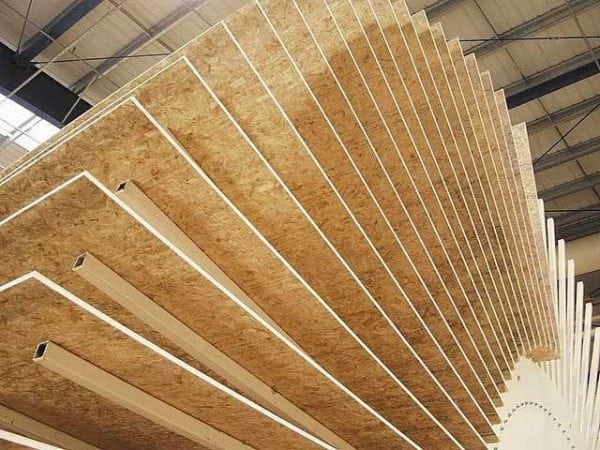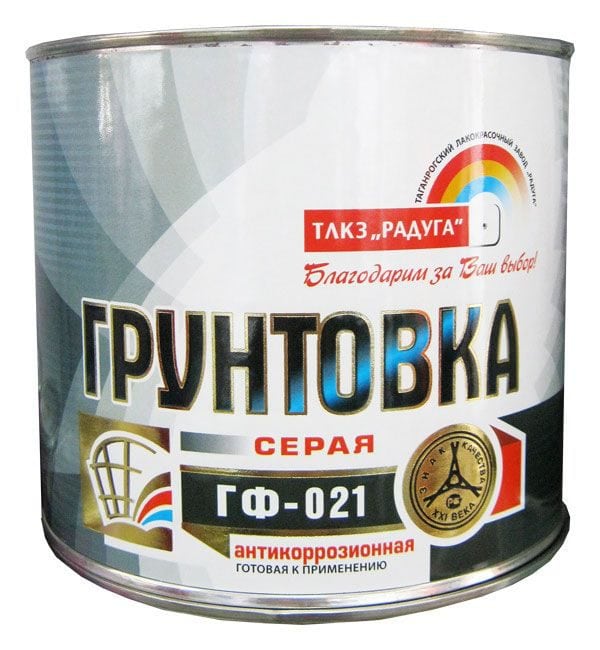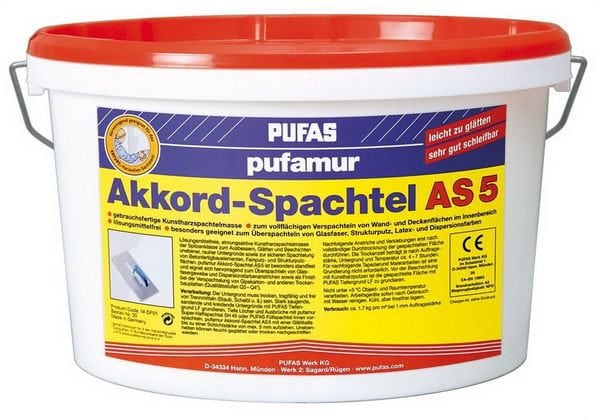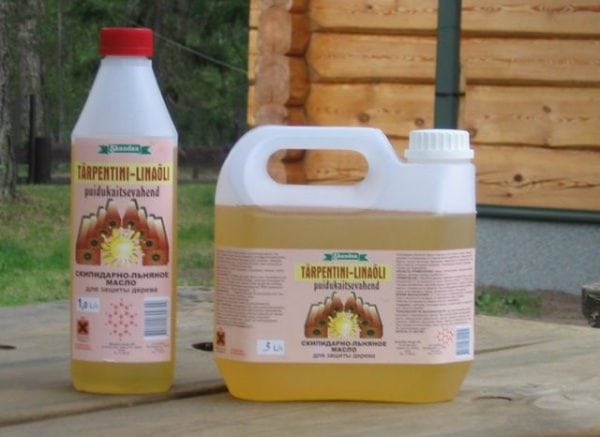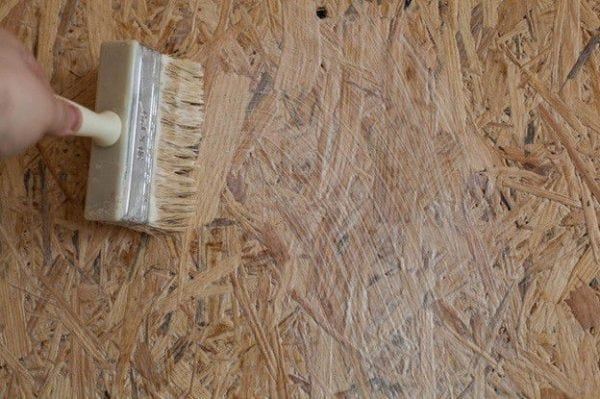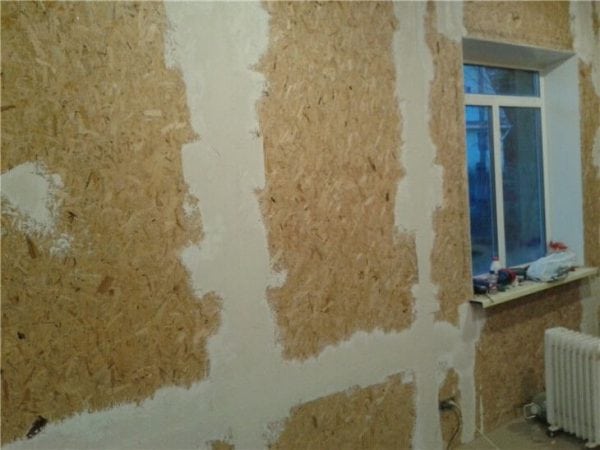OSB plates are used in the construction of frame houses. To protect the panel material from the negative environmental influences, it is recommended to apply a protective finish on it. Outside buildings, hinged facade systems are most often used, and putty is used in the premises. This article will discuss how and how to putty OSB.
- general information
- Features of finishing materials
- Primer selection
- Choice of putty
- Putty Requirements
- Do-it-yourself putty making
- Putty Technology
- Preparing OSB for puttying
- Puttying
- OSB plastering
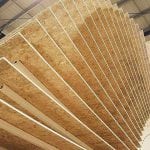
general information
The abbreviation OSB is actually a Russian pronunciation of the English abbreviation OSB, which means - Oriented Strand Board. This name is translated as approximate chipboard (OSB). Thus, OSB is a more correct name than OSB, if it is necessary to denote the function of this material in Russian.
Oriented particle board is a multilayer structure made from wood chips, which sticks together at high temperature under pressure. As an adhesive, synthetic resin is used. Also in the composition of the OSB is synthetic wax and boric acid.
The direction of stacking the chips in different layers is different. For example, in the outer layers, the chips are located longitudinally, and in the inner layers it is laid across. Thanks to this, the plate acquires high resistance to mechanical type influences.
Despite the mechanical resistance and aesthetic appeal, OSB designs need additional finishing with putty. Firstly, the OSB putty evens the surface, which then allows you to glue wallpaper on top of the prepared coating or apply paintwork. Secondly, the putty allows you to extend the operational life of the walls and ceilings in the house.
Like any material made of wood (and OSB 80-90% consist of wood shavings), approximate chip boards absorb moisture. It is this quality that makes many doubt the feasibility of puttying OSB. After all, paint and wallpaper glue in the future can cause a swelling of the base and its deformation. The way out is the refusal to use water-based mixtures. No water - no risk of base swelling.
Note! OSB's resistance to moisture varies by brand. The most moisture resistant are considered OSP-3. Such panels are designed for installation in rooms with a high level of humidity.
With all of the above, one can not fail to note the fact that many are quite happy with the natural look of orientated particle boards. This kind of view is quite appropriate for country houses or utility rooms. Moreover, if desired, the panels can be varnished.
to contents ↑Features of finishing materials
When choosing material and carrying out work, a number of requirements must be taken into account.
Primer selection
Before applying putty, it is necessary to first grind, and then prime the surface.
Note! For sale are polished OSB. They cost a little more than unpolished ones, but the labor costs for their preparation are much lower.
The primer you need to buy is not any, but specifically designed for wood processing. Such formulations do not contain water.For example, primers based on drying oil or glyphthalic varnish are suitable.
The most vulnerable place in the OSB (from the point of view of moisture permeability) are the end parts. These areas need to be well primed before the sheets are installed, otherwise this will not work in the future.
to contents ↑Choice of putty
Only special formulations are suitable for OSB processing. If the putty is intended for something else, for example, for processing concrete, then it is most likely not suitable for wood.
So, the following types of putties are used for wood (they are sold ready-made):
- Acrylic putty for OSB. It is used for leveling any wooden surfaces, including wood-shaving.
- Nitro-fillers. They are quick-drying formulations made on the basis of cellulose, resin, plasticizers, fillers and organic solvents. As a solvent, brands such as P-645 or P-649 can be used. Among the popular nitro-fillers, MBSH, ASH-24 and ASH-32 can be distinguished.
- Putties based on oil and glue. The composition contains drying oils, varnishes and adhesives, as well as chalk, modifiers and thickeners. The solvent acts as a drying oil. The most famous representatives of oil-glue compositions - LSH-1 and LSH-2.
- Glue solutions. The basis is glue and, in slightly smaller quantities, oil. Plasticizers are used as an adjunct.
- Plaster putties. They contain not only gypsum, but also polymer additives. Plaster mixtures are considered the most suitable for the processing of wooden products. Among the compositions of this group it is worth noting such well-known brands as "Goldband", "Rotband" and "Vetonit".
- Dispersion mixtures based on synthetic resin. The most famous example for the craftsmen is the German PuFAS Pufamur Akkord-Finish AS 5 putty. This primer is characterized by excellent elasticity and is used as a finishing composition when processing a plastered surface.
Putty Requirements
Regardless of the material on which the putty is made, it should have the following characteristics:
- Excellent adhesive properties (the ability to adhere to heterogeneous smooth materials), since not every putty is capable of contacting with a resinous surface.
- Slight shrinkage as a result of drying (this quality prevents cracking).
- The strength of the formed coating.
- The coating should be not only durable, but also amenable to grinding.
- Uniformity of consistency.
- Lack of solid additives.
To ensure that there are no cracks in the OSB, it is recommended that the surface be reinforced with elastic materials. Best for these purposes is suitable non-woven fabric. Non-woven glued with wood glue.
to contents ↑Do-it-yourself putty making
The cost of factory putty is not too high. However, if you need to process large areas, including walls, floors, ceilings, then the total cost of leveling may not be so small. Therefore, some craftsmen decide on their own production of wood putties.
To create a putty composition you will need the following components:
- linseed oil - 280 g;
- turpentine oil - 60 g;
- ground pumice - 30 g;
- gelatin - 20 g;
- casein - 20 g;
- ammonia solution (18%) - 17 g;
- water - 300 g.
First, grind the pumice to a dust state. Then we pour the resulting mass into a container with linseed oil and stir until we get a homogeneous consistency. Next, pour turpentine oil into the same dishes and stir the mixture well again.
The mixed mass is allowed to infuse for several minutes, after which we add the remaining components from the list.The solution is prepared in a water bath, then stirred and infused again. After the last settling, the mixture is ready for use.
to contents ↑Putty Technology
So, all the necessary materials are purchased or manufactured independently. Now you can begin to putty.
Preparing OSB for puttying
As mentioned above, before you putty OSB, we process the surface with a primer. It is impossible to do without priming, since an unprepared surface will not adhere well to the putty. In addition, in the future, priming will prevent the appearance of all kinds of wood components (resins, essential oils, tannins) on the surface.
The primer is performed in two passes. First, apply soil that does not contain water. Then the surface is painted with a white insulating paintwork (for example, “PUFAS Agua-Deck E.L.F.”).
Note! If OSB was previously varnished at the factory, then it can immediately be coated with white insulating paint.
After priming, it is recommended to take a technological break for the drying of the material. Depending on the soil, the waiting time can vary between 3 and 12 hours.
to contents ↑Puttying
Putty by OSB is applied only at positive temperature and air humidity not exceeding 60%. We put the putty on a tray, from which the material is selected with a spatula and applied to a wooden surface. Periodically, after processing a significant area, we trim the resulting coating.
After the entire surface has been treated, we take another break for the material to dry. After that, we grind the already dry surface to remove small defects from it and give the maximum possible smoothness.
It remains to perform surface reinforcement. To do this, glue the lap non-woven. To avoid thickening, we make double cuts in these places and remove excess material. The adjacent panels are fixed butt.
So, the process is not too complicated, any beginner can easily cope with the work. If there is no self-confidence yet, it is better to trust the professional skill.
to contents ↑OSB plastering
About whether it is possible to putty OSB, we described above. Nevertheless, we will briefly consider the issue of plastering tentatively particle boards.
Plastering wood is a much more difficult task compared to plastering concrete or brick. The fact is that, unlike the indicated materials, the wood adheres to stucco much worse, which leads to cracking and peeling of the finish.
To ensure high-quality plastering, it is necessary to observe the following sequence when performing work:
- We create hard mounts for OSB.
- Primer the surface with an adhesive composition.
- We apply plaster with a spatula (layer thickness - from 2 to 3 millimeters).
- On a still-dried coating, install a reinforcing mesh (we press it into the plaster).
- When the first coat of finish dries, apply the adhesive solution to the surface. Level the coating.
- We apply decorative plaster.
If you plaster the facade of a frame building, the appearance of the surface will be indistinguishable from the surfaces of buildings erected from other types of wall materials.
Advice! So that the plaster does not crack at the joints of the OSB, the joints must coincide with the supports and crossbars of the battens.
So, puttying OSB is not necessary. However, if in the future it is planned Wallpapering or surface painting, can not do without puttying.

